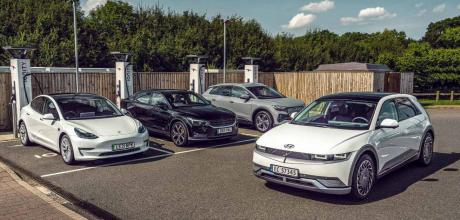2022 Hyundai Ioniq 5 vs. Audi Q4 E-Tron, Tesla Model 3 and Polestar 2
Right here, right wow. Your £50k future EV has already landed. Beyond the tech and the flash, do newcomers from Hyundai, Volvo and Audi have the substance to topple Britain’s best-selling EV, the Tesla Model 3? Words Tim Pollard. Photography Jordan Butters.
ELECTRIC ONSLAUGHT!
We’re gonna need our X-ray specs for this Giant Test: to see through the fart modes in Tesla’s Toybox, the achingly cool Tonka style of the Back To The Future Ioniq 5, the Audi’s dancing strobe lights and quartic steering wheel, and Polestar’s vegan interiors and builtin Google Assistant. This quartet is bristling with innovation and gadgetry, but it’s our job to separate the sweet from the naff, the super from the superficial. They’re a disparate bunch – one notchback and one SUV, a saloon and a super-sized hatchback – but united in their increasingly viable electric powertrains allowing a claimed 300-ish miles between top-ups and style that’ll make you want an electric car rather than merely need one to poleaxe your tax bills.
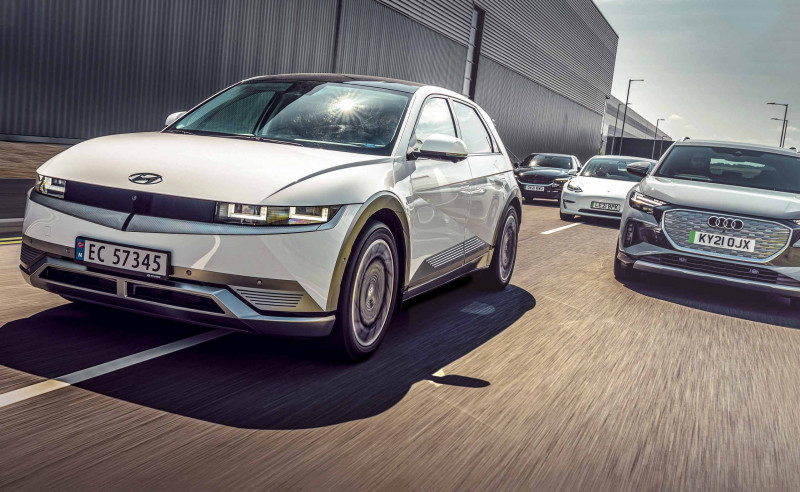
A dozen years after Nissan’s Leaf ushered in the attainable bespoke EV, the breed’s come full circle: from geeky, sandal-wearing curio to the model that Audi UK predicts will be its second most popular range after the A3 as early as next year. Yep, the box-fresh Q4 e-Tron is likely to sell in big numbers thanks to its mix of SUV practicality, purity and pricing to lure crossover-crazy Brits. It’s deliberately positioned conservatively to make plugging in less daunting. It’s perhaps the most normalised EV on test.
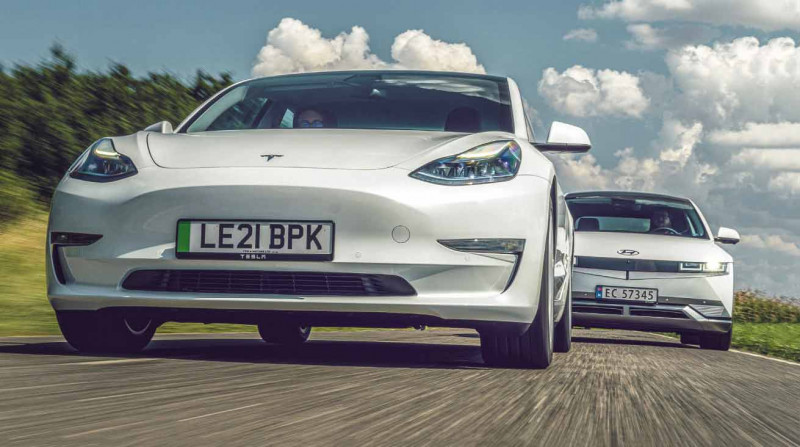
If you find the Audi a little too like the Q3 and Q5 whose styling it apes, may we present Hyundai’s Ioniq 5? A car so removed from the dullards whence its name came that you’d be forgiven for demanding a paternity test. But if the regular Ioniq family was a low-profile warm-up act, then it was clearly worth the wait: the 5 looks like the product of a design team who’ve held a putsch and stormed the boardroom. We struggle to remember the last time a concept car escaped from the studio and broke into showrooms having barely bothered to remove its motor-show wristband. Original Audi TT, maybe?
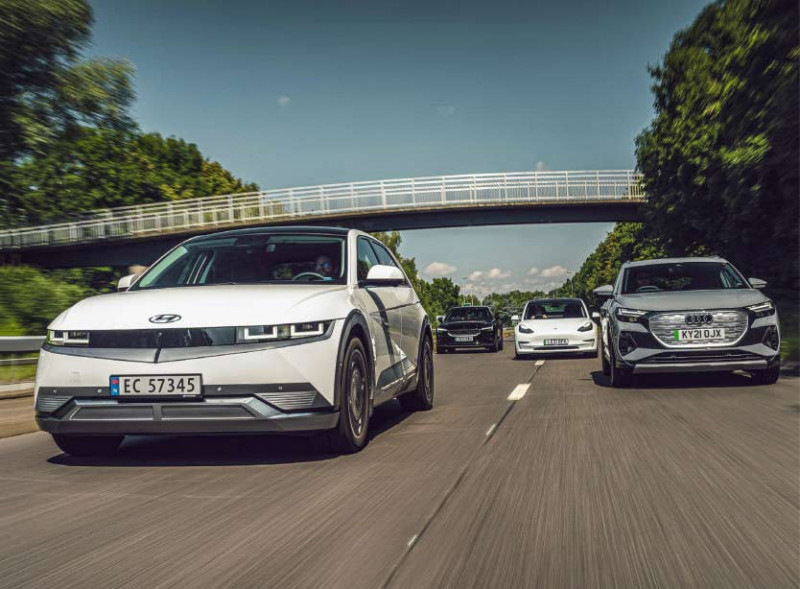
It might be possible to write about EVs and not mention the T word, but this circa-£45k EV super-group couldn’t be assembled without a Tesla Model 3. The car that took Elon Musk’s brand from startup to major player, it’s set the benchmark for mid-sized electric cars for a couple of years now and has won every test we’ve thrown its way. This is the UK’s best-selling electric car in 2021; some months it’s the best-selling car full stop, outperforming even the hot-cakes Corsa, Fiesta and Golf. There are few more talented EVs at this price, and a series of 2021 refreshes brings greater range and more polish to the design, inside and out.
Our final contender is the Polestar 2 – a Tesla wannabe dripping with Scandi chic. The range is stretching down below the £40k barrier now, with the launch this summer of smaller-batteried and two-wheel-drive versions, but we’re testing the long-range AWD original. It looks like a saloon, but a tailgate gives the 2 a dollop more practicality than the Model 3 it so clearly targets. Even the sales model is similar to Tesla’s, with a predominantly online buying process, although Polestar Spaces have opened in London and Manchester. Progressive types may accept these more digital touchpoints; traditionalists may prefer to pop into their local Hyundai or Audi dealer.

As we gather early on a Monday, all eyes are drawn to the Hyundai. And when’s the last time we wrote that? The Ioniq 5 is a beguiling design, echoing the old Pony but shot through with a very modernist vibe. Perhaps the biggest shock on first acquaintance is just how darn big it is. The photos are misleading; you expect a Golf-sized funster, but what you get is a massive hatchback on stilts, like a Discovery Sport repackaged, Transformer-style, into a C-segment five-door on steroids. Wherever you look are achingly cool details, from pixelated cubic light graphics to the solar roof and illuminating chrome grille. It’s a busy, postmodern design that’s trying very hard, but it somehow works brilliantly. Just wow.
It’s a sign of how far the Korean motoring revolution has come. From the SUVs and i family cars that set the ball rolling in the Noughties, through the N-badged hot hatches that made us sit up and take notice, to the early electric and hydrogen cars that proved brilliant but boring. It looks like some welcome swagger has been engineered into the new E-GMP platform under the 5 (and a host of other incoming pure electric Hyundais).
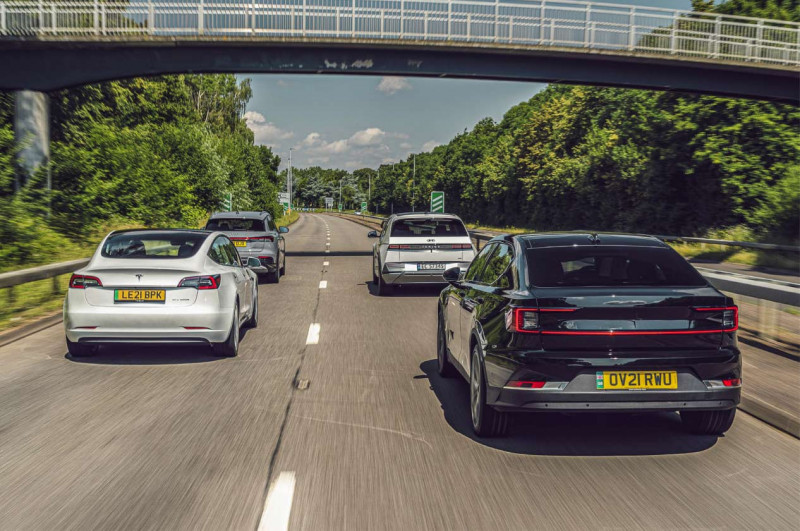
With ultra-fast 800-volt charging systems and the ability to power other electric devices like e-bikes (or even your home), it’s a thoroughly clever piece of kit.
That stance on the road isn’t imagined: the Ioniq is nearly as tall as the Q4 e-Tron and the second longest car here, wrapped around a huge three-metre wheelbase with wheels pushed to the extremities. So you step into an echoingly vast cabin: come expecting Golf space and you’ll be blown away. All four cars are roomy up front, but the Hyundai is exceptionally spacious in the back too, where passengers are treated like kings, bathed in soft diffused light from the full-length sunroof. That rear bench slides back and forth and reclines, letting you juggle space for luggage and limbs; it’s surprisingly practical.
The cockpit is as futuristic as the exterior. The designers have really thrown everything at the 5’s interior and conventional thinking is challenged wherever you look: the glovebox pulls out like a filing cabinet, rather than flopping down; the entire centre console slides back and forth on rails and the front seats are like the La-Z-Boy loungers from Friends; there’s even an Ioniq-logo fridge magnet on the driver’s dash speaker so you can attach directions or a shopping list. It all sounds too much on paper, but even with our most cynical X-ray specs firmly on, most testers recognised the creativity at play. If you prefer your cabins traditional in flavour, you’ll hate it – but we suspect progressive types will find it refreshing.
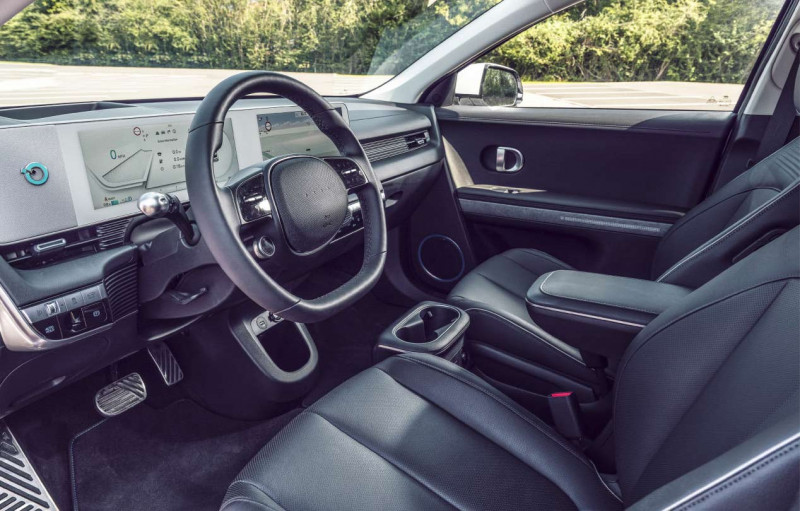
Step from the Ioniq into the Polestar and you enter a similarly modern cabin (once you’ve got over the horrible, plasticky take on Volvo’s fiddly key). The Hyundai’s choice of materials is spot-on, all recycled plastic bottles and modernist fabrics, but the Polestar’s is just as sustainable – it’s even vegan approved. But where the Hyundai champions a cool-tech approach, Polestar favours a more Scandinavian, minimalist style. The 2 is a beacon of understated calm. There are few buttons and most functions are packed into the world’s first application of the Android Automotive Operating System. Forget what you’ve experienced in other brands’ voice control. The Google system recognises free speech better than any other car I’ve tested; it’s not foolproof and it crashed once during our test, but proffers a glimpse of where AI will take the automobile in future. It doesn’t look like we’ll be talking about switchgear quality for much longer.
The Polestar is lovingly assembled and feels like a Volvo that’s had a gap year in California. It’s just hampered by its body style. This is the least practical car here: it has the smallest boot, that notchback shape restricts the view out of the rear window into a strange pillar-box slit, and the short rear doors access a bench more cramped than any rival’s. We can only imagine that – like Tesla – Volvo elected to choose a sedan-alike shape to launch, owing to global demand for three-box shapes in markets such as the US and China. The upcoming Polestar 3 crossover will be more in keeping with European mores.
Time to check out the arch enemy. Every car here has a centre console dominated by a touchscreen (minimum size: 10in) and we can blame Mr Musk, a decade since we were first bowled over by the Model S’s huge screen. So the Model 3’s 15in landscape-orientated screen, weirdly, doesn’t seem that big or innovative any more, but the Apple-like operating system and logic is exemplary, even if you may be irritated by just how much is packed into the digital menus. Do we really want wipers in there?
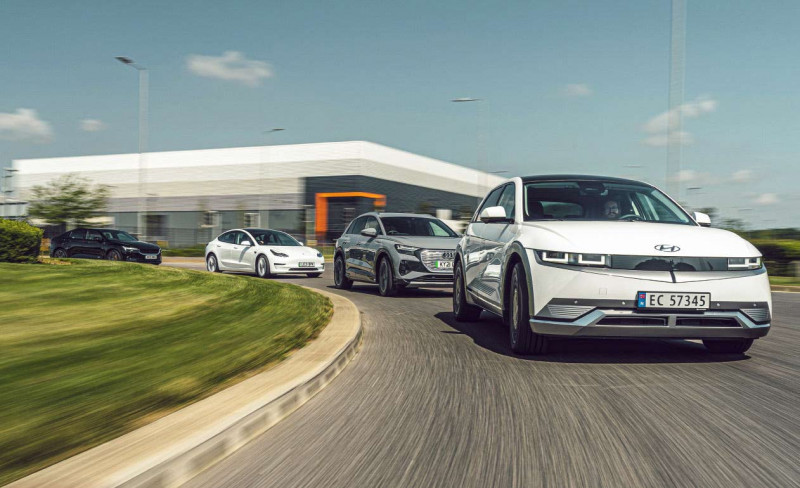
We’ve previously criticised Tesla quality but this 2021 Model 3 feels better built and there are useful cosmetic updates, although it’s still a rung below these rivals. You’ll spot the latest version by its smoked black trim around the window line, door handles and mirrors, replacing chrome brightwork. Inside there’s more matte black trim, an additional storage box in the centre console, improved steering wheel buttons, a heat pump and suede-trimmed wireless charging bays for two phones. It’s roomy in both rows and, even though it’s a saloon, you can flop the rear seats down to transport longer items.
Jump into the Q4 e-Tron after these three tech-heads and it’s very… conventional. Happily that means Teutonic logic, lush materials and familiar design motifs.
Replace the power meter with a revcounter and you’d barely notice. The MEB electric innards make this an especially roomy interior and for families needing frequent seating for four or five, it’s the best here. It might have the smallest footprint, but those SUV aspirations hike its status to tallest car on test and the boot is a good shape with the second largest load volume (if no frunk).
Thumb the start button, nudge the stubby gearlever into D or B for extra regen braking and the Q4 whispers away. Acceleration is surprisingly sluggish in this age when even quite humble EVs slingshot off the line, but you adapt and it’s well judged for the average Audi Associate (the Mondeo Man of the 21st century?). It’s heaviest on test at 2125kg, which doesn’t help, and we’re driving the 201bhp single-motor version, not the 295bhp Quattro twinny. It feels taller and softer and squidgier than its peers and there’s not a lot of fireworks or fizz. Rather the e-Tron goes about its EV business with quiet polish, a compliant ride and some impressive energy stats.
As part of our test we brimmed each car overnight on a 7kW wallbox (each can fast-charge at a public rapid charger, with the following thirst for sparks: Audi 125kW, Hyundai 350kW, Polestar 150kW and Tesla 250kW), and drove all four cars over the same 23-mile mixed test route under identical settings for heating and interior features. The Audi gobbled electricity at the rate of 3.6 miles per kilowatt hour – trailing only the frugal Tesla (4.0 miles per kWh) and nudging ahead of the Hyundai (3.4 miles). We were disappointed by the Polestar’s 2.0 mile average consumption, reinforcing the official WLTP stats that the 2 is the least efficient car here. The Audi’s 82kWh battery is the joint biggest and provides a claimed 316-mile range, although the trip computer showed a maximum of 218 on a baking hot summer day.
The futuristic Hyundai has the smallest battery capacity on test at 73kWh, but its on-test range matched that of the Audi (218 miles, versus a claimed 267). The Ioniq 5’s acceleration is in a different league thanks to a 301bhp electric motor, the huge cartoonish styling disguising hot-hatch pace with 0-62mph gone in 5.2 seconds, over three seconds faster than the Q4. Twist a tactile, cool-looking rotary gear selector and the Hyundai continues to surprise and delight as you drive, from the pop-up blindspot video stream when you indicate, to the ‘handclap’ sunroof blind that shutters from both ends. It’s an innovative, think-different car, and somehow manages to work without feeling gimmicky.
Driven in isolation, the Hyundai is deeply impressive, but when it’s sparring with the EV top table the ride quality is revealed to yaw and float and heave where other bodies are better clamped down over uneven surfaces. Steering feel is negligible and simple laws of physics dictate that a 2.1-tonne hatch standing over 1.6 metres tall can’t be hustled as you could an i30 N. No wonder the Michelin Pilot Sport 4 tyres are marked ‘Extra Load’. Time to switch to the lower-slung Polestar. It feels like a go-kart in comparison with the Hyundai and Audi, all hunkered down and sporty, your body strapped in place by the Performance Pack’s bright yellow seatbelts.
There’s no start button, simply nudge the stubby lever into D and we’re off, surfing plentiful grunt from twin e-motors. Peak power is 402bhp – it feels supercar-fast when the traffic thins and you plant the right pedal. Polestar quotes 4.7sec 0-62mph and you can believe it. Thank goodness for the uprated Brembo brakes fitted to our car, which wipe speed off instantly (though one-pedal regen braking in the Polestar is well judged and when in non-hooligan mode you rarely touch the left pedal).
There’s real sophistication to how the Swede drives and the steering and chassis are well judged, apart from a firmness to the ride that is just too jiggly for British roads. Polestar champions the adjustable Öhlins dampers, but every 2 we’ve driven has been too firm; we’d prefer one set-up that worked from the get-go.
So to the Model 3, our reigning class benchmark. It’s remarkable how the entry-level Tesla now feels subtle in this company, low-key even. The small steering wheel and lack of conventional instruments is similar to Peugeot’s i-Cockpit arrangement and by the first corner you clock how the car turns instantly, with a pointiness that calls to mind Ferrari’s quicker racks. Yes, really. It also rides better than the Polestar or Hyundai, and it may be no coincidence that its 19-inch alloys are the smallest fitted to any of the cars on this test.
The chassis impresses and so does the powertrain. You can pootle on a motorway, enjoying the impressive but misleadingly named Autopilot function, the peace and quiet, the sentient camera sensors that pick out cars, lorries, even traffic cones – or you can introduce right foot to carpet for the most violent acceleration this side of a McLaren (0-62mph takes 4.2sec). Ours is only the Long Range model and not a Performance, but full-bore sprinting is brilliant, the 434bhp and a kerb-weight 300kg below the competition bringing serious speed.
The Model 3 withstands the closest scrutiny, then, even after you see through the Santa modes and Elonian fripperies: its range on test was nearly 100 miles beyond any rival, it goes significantly further for every kilowatt hour and when you do need to charge there’s a 756-strong Supercharger network dotted across 84 UK locations. It’s a reminder just how advanced Tesla’s electric-car capabilities have become over the past decade.
FINAL RECKONING
5, Q4, 3, 2… and then there was oneThese four EVs come in disparate shapes and sizes, but are united by batteries, budgets and bright, progressive characters. Each one feels fit for the zeitgeist as Britain prepares for the Great Fuel Switchover and you won’t put a foot wrong with any as your first taste of EV ownership. Which you’d pick will ultimately depend on your appetite for form over function, coolness over capability. Do you want to make a statement as you plug in? Or would you rather be reassured by a welcome dose of familiarity?
If it’s the latter, the Q4 e-Tron is a well-judged introduction to electrification. It looks and feels exactly like an Audi should and benefits from the brand’s reputation for Germanic quality, ergonomics and comfort. We especially like the e-Tron’s roominess – there’s as much space as in a Q5 from the class above and it’ll make great family transport. But CAR champions cars with fizzy character to accompany rational excellence, and the Q4 is a mite too sensible. You’d feel prudent at the wheel, not fulfilled.
Enter the Polestar. We’re big fans of the 2 and its Volvo-meets-Tesla spirit. The Scandi design in and out is a winning combo while performance and handling provide the thrills that the Audi can’t; we just wish the ride quality wasn’t so bumpy and energy consumption was more competitive. We suspect the forthcoming Polestar 3 crossover will solve the packaging issues that blight the 2; this is the least accommodating car on test. Quite the opposite problem with the Hyundai Ioniq 5. Its size in the metal is a real surprise – you could viably pick the Korean car as transport for an older family. It’s almost like they’ve invented a new body style: the super-hatch. Performance is super-fast, too, and it’s a hoot to drive, but the 5’s real ace is that exciting design. It’s a hugely refreshing package and one that nearly stole top honours, let down only by sloppy body control and a nagging worry that it’s trying a little too hard.
Which means the original EV pioneer is still ahead, by a nose. We were amazed by how normal the Tesla Model 3 now feels. Rivals have had to turn the innovation dial up to 11 to catch up and the Californian is now feeling less shouty, more mature. The Model 3 Long Range does exactly what it says on the tin, with a razor-sharp drive, a clever, subtly improved cabin and the best EV skillset of any brand on the planet. The original EV catalyst is still quite the catch.
- 1st TESLA MODEL 3 Still the best mid-sized electric car on the planet
- 2nd HYUNDAI IONIQ 5 The coolest EV on sale today: original, clever, brilliant
- 3rd POLESTAR 2 So good in many ways, let down by ride, packaging, range
- 4th AUDI Q4 E-TRON Polished all-rounder, lacks spark in the driving department
With EVs this tempting, we’re going to need more charging points.
Q4 sluggish for an EV, joint-worst range on test. Will sell like hot cakes Ioniq 5 looks like a hatch, but it’s big like an SUV.
Q4 is familiar Audi inside, with a dash of Lambo edge. Dual e-motors = AWD and 434bhp. Bof.
The Polestar feels like a go-kart compared with the Hyundai and Audi. Polestar: like Tesla gone sub-zero.
The Hyundai has the smallest battery capacity on test at 73kWh, but its indicated range matched the Audi.
Polestar’s superior 0-62mph not illustrated here. Q4 e-Tron: soon to be Audi’s almost-bestseller.
Blimey. Zero traffic, zero emissions… living Generation Zoom’s dream drive to work. Ioniq 5 interior is innovative and refreshingly different. Huge too. Hyundai vs Polestar? EV landscape blurs old tribal loyalties Model 3 somehow already the old kid on the block. Tesla: still with huge screen, now with better build quality.
The designers have thrown everything at the Ioniq 5’s cabin, with conventional thinking challenged everywhere you look
The Tesla is the UK’s best-selling electric car in 2021; some months it’s the best-selling car full stop.
PRE-FLIGHT BRIEFING HYUNDAI IONIQ 5
Why is it here?
Just look at it! Have you EVER seen a Hyundai look this cool before? The Ioniq 5 feels like one of the cars of the moment – but it crucially also ushers in Hyundai- Kia’s new Electric Global Modular Platform, aka its new EV skateboard architecture, which will underpin many new models.
Any clever stuff?
E-GMP brings super-fast 800v charging capability, a range over 260 miles, clever blindspot cameras (pictured) and the ability to charge other electric devices, such as e-bikes. It’s a significant investment and brings together everything Hyundai’s learned from the Kona and other Ioniqs.
Which version is this?
We snaffled a go in this high-spec Norwegian-market Ioniq 5. It’s closest to the UK’s Ultimate trim, which is the top-dog 5 now that the launch-edition Project 45 models have sold out. It shares that car’s solar roof for trickle-charging the battery when parked up.
PRE-FLIGHT BRIEFING AUDI Q4 E-TRON
Why is it here?
This car is important to Audi: after the warm-up act of the e-Tron SUV and the sportier GT models, the Q4 signals the start of mass-market electrification at Ingolstadt. Audi UK predicts it’ll become the second-biggest seller here (behind the A3) as early as next year.
Any clever stuff?
Underpinning the Q4 is the VW Group’s MEB modular electric architecture (right) – the hardware used across the VW empire from ID.3 and ID.4 to Skoda Enyaq and Cupra Born. This industrial economy of scale should enable cutting-edge tech at more democratic prices.
Which version is this?
This is the likely best-seller, the Q4 e-Tron 40 Sport – the Goldilocks of the range, being neither the puniest 35 entry-level model (whose range dips as low as 193 miles) nor the unnecessarily fast and expensive 50 Quattro (whose price tops out at £65k). It’s the one we’d buy.
PRE-FLIGHT BRIEFING TESLA MODEL 3
Why is it here?
The smallest and cheapest Tesla has taken Elon Musk’s EV ambitions to the masses: now a familiar sight across the UK, the Model 3 was the best-selling electric car in the UK in the first half of the year. For good reason: it still sets the benchmark for fresh-thinking electric transport.
Any clever stuff?
Mainstream makers are catching the original disruptor, but Tesla still holds a few aces. You can summon this car from your mobile and the Supercharger fast-charge network continues to expand: this summer new sites have opened from Cardiff to Cambridge.
Which version is this?
We’re testing the Long Range, the mid-ranking M3 that slots between Standard Range Plus (£40,990) and Performance (£59,990). It adds Dual Motor for all-wheel drive and packs a battery capacity estimated at 82kWh (Tesla no longer publishes cell size, annoyingly).
PRE-FLIGHT BRIEFING POLESTAR 2
Why is it here?
Volvo’s been on a roll for a while now – so when the Swedes launch a standalone electrified brand it’s time to pay attention. Billed as the Scandinavian answer to Tesla, Polestars are aimed squarely at progressive types seeking transport with a wholesome twist.
Any clever stuff?
Perhaps the cleverest bit is the Google operating system powering its infotainment. The first application of Android OS in the automotive sphere, it syncs with the Google ecosystem, so you can control your calendar, contacts, music and other associated G-suite elements.
Which version is this?
The AWD 78kWh original, but the range grew this summer to include two cheaper front-drive variants; you can now order your 2 with the 78kWh battery pack and one driven axle for a range of up to 336 miles, or a single motor with a smaller-capacity 64kWh battery.
SECOND OPINION TOM WILTSHIRE
Despite all the hype the Ioniq 5 left me weirdly numb. I love the looks and I appreciate Hyundai taking an unconventional approach by making a jumbo hatchback. It’s let down by its chassis, which I don’t think can cope with the weight it’s being asked to lug around, and doesn’t ride particularly well. The pitching back-and-forth motion would make me seasick after a while. The interior has plenty to like but, again, some baffling design decisions: why on Earth are the front-seat heater controls buried in a menu, while rear passengers get physical switches? There’s plenty of space for passengers but a shallow boot – and the tiniest little frunk too.
SECOND OPINION KEITH ADAMS
To be honest, the Q4 was invisible and outclassed in this grouping, possibly because this was a low-spec Sport trim. In usual Audi style, the screens and infotainment worked well, and range/ battery management looked good. But I found performance lacklustre and the steering was pretty average in terms of weight and feel. Handling had no vices, while ride wasn’t as stiff as the Polestar and on a par with the Hyundai, although it was similarly afflicted by the quirk that affects all ID.4-based cars I’ve driven, where sharp ridges and imperfections jolt through – almost like the tyres are underinflated. I’d just take a Skoda Enyaq.
AFFORDABILITY Polestar keenest price if you’re paying monthly, which is the smart way to go EV
POWERTRAIN Four long-range beasts – the Tesla and Audi especially with 82kWh cells
PERFORMANCE Three zoom like Porsche; Audi meanders like Proton
BODY/CHASSIS Tesla a relative lightweight, despite largest footprint: only EV here to dip under two tonnes
EFFICIENCY Tesla streaks ahead with stingiest energy management and longest range tested by… miles
HYUNDAI IONIQ 5
- Price £51,520 (£53,700 as tested)
- Predicted PCP £528.95 per month (x 48): £5000 deposit, 10,000 miles per year, 4.8% APR
- Typical approved-used value N/A – too soon
- Twin electric motors, 73kWh lithium-ion polymer battery, single-speed transmission, all-wheel drive
- Structure Steel
- Weight 2100kg
- Suspension MacPherson struts (front), multi-link axle (rear)
- Length/width/height 4635/1890/1605mm
- Boot capacity 527 litres (+24-litre frunk)
- Official consumption 3.3 miles per kWh
- Tested consumption 3.4 miles per kWh
- Electric range 267 miles
- Electric range (tested) 218 miles
- Emissions 0g/km CO2
- Max Power 301bhp
- Max Torque 446lb ft
- Top speed 115mph
- 0-62mph 5.2sec
AUDI Q4 E-TRON
Price £44,275 (£52,110 as tested)
Predicted PCP £556.62 per month (x 47): £5000 deposit, 10,000 miles per year, 4.9% APR
Typical approved-used value N/A – too soon
Single electric motor, 82kWh lithium-ion battery, single-speed transmission, rear-wheel drive
Structure Steel
Weight 2125kg
Suspension MacPherson struts (front), four-link axle (rear)
Length/width/height 4588/2108/1632mm
Boot capacity 520 litres (no frunk)
Official consumption 3.5 miles per kWh
Tested consumption 3.6 miles per kWh
Electric range 316 miles
Electric range (tested) 218 miles
Emissions 0g/km
Max Power 201bhp
Max Torque 229lb ft
Top speed 99mph
0-62mph 8.5sec
TESLA MODEL 3
Price £47,500 (£54,490 as tested)
Predicted PCP deal £580 per month (x 48): £5000 deposit, 10,000 miles per year, 4.9% APR
Typical approved-used value £46k (46,300-mile Long Range)
Twin electric motors, 82kWh (est) lithium-ion polymer battery, single-speed transmission, all-wheel drive
Structure Aluminium, steel
Weight 1801kg
Suspension Double wishbones (front), multi-link (rear)
Length/width/height 4694/2088/1443mm
Boot capacity 425 litres (+117-litre frunk)
Official consumption 4.2 miles per kWh
Tested consumption 4.0 miles per kWh
Electric range 360 miles
Electric range (tested) 341 miles
Emissions 0g/km CO2
Max Power 434bhp
Max Torque 364lb ft
Top speed 145mph
0-62mph 4.2sec
POLESTAR 2
Price £49,900 (£58,900 as tested)
Predicted lease: £488 per month (x 48): £5859 initial payment, 10k miles per year
Typical approved- used value £49k (3500-mile long-range, dual motor) Twin electric motors, 78kWh lithium-ion battery, single-speed transmission, all-wheel drive
Structure Steel
Weight 2123kg
Suspension MacPherson struts (front), multi-link (rear), adjustable Öhlins
Length/width/height 4606/1985/1477mm
Boot capacity 405 litres (+35-litre frunk)
Official consumption 3.2 miles per kWh
Tested consumption 2.0 miles per kWh
Electric range 292 miles
Electric range (tested) 250 miles
Emissions 0g/km CO2
Max Power 402bhp
Max Torque 487lb ft
Top speed 127mph
0-62mph 4.7sec


